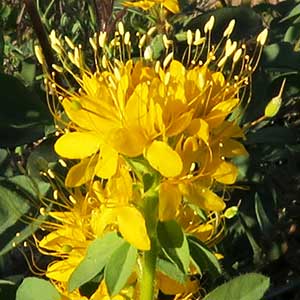Peritoma platycarpa
golden bee-plant, golden spiderflower
densely branched basally; purple-tinged;
glandular-pubescent.
(stipules scalelike, minute, obscured by pubescence);
petiole 1.5–4.5 cm;
leaflets 3, blade flat, ovate to obovate, 1–3.5 × 0.5–1.3 cm, margins serrulate-denticulate or entire, apex obtuse, surfaces glandular-pubescent.
1–3.5 cm (5–40 cm in fruit);
bracts unifoliate, obovate to spatulate, 3–25 mm.
7–17 mm.
sepals deciduous, distinct, yellow, awl-shaped, (3–)4–5(–6) × 3–7 mm, margins entire, densely glandular-hairy;
petals golden yellow, oblong, 6–12 × 0.3–0.4(–0.6) mm;
stamens yellow, 10–17 mm;
anthers 1.8–2 mm;
gynophore 10–18 mm in fruit;
ovary (compressed), 3.5–5 mm;
style 1–3 mm.
(pendent) not inflated, 12–25 × 8–12 mm, striate, (glandular-pubescent).
10–20, brownish black, spheroidal, 3–3.2 mm, (glossy) smooth.
= 40.
Peritoma platycarpa
Peritoma platycarpa resembles some species of Cleomella in the absence of a nectary-disc, shape of the replum, and indument.
(Discussion copyrighted by Flora of North America; reprinted with permission.)
- Local floras:
CA,
OR
- Local Web sites:
CalFlora,
CalPhotos,
Flora NW,
PNW Herbaria
WildflowerSearch
iNaturalist (observations)
- LBJ Wildflower Center
- SEINet
- Plants of the World Online
- Encyclopedia of Life
- Wikipedia
- Google Image Search


